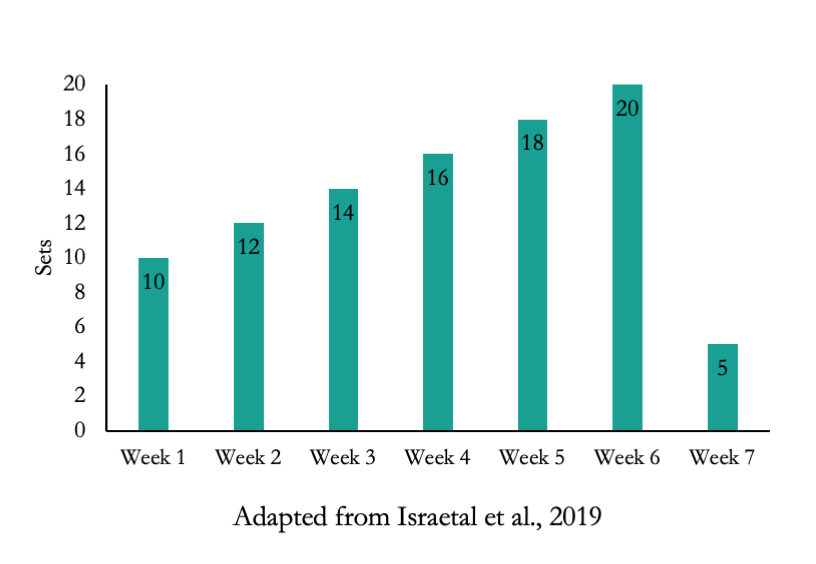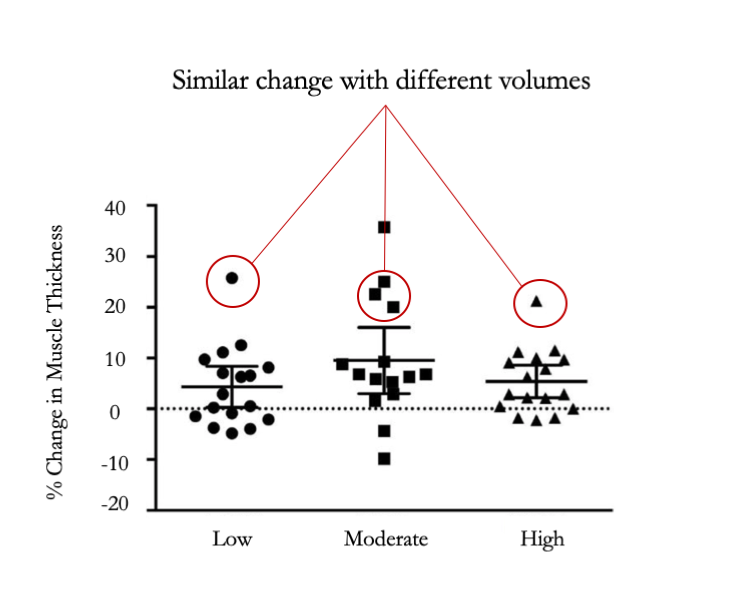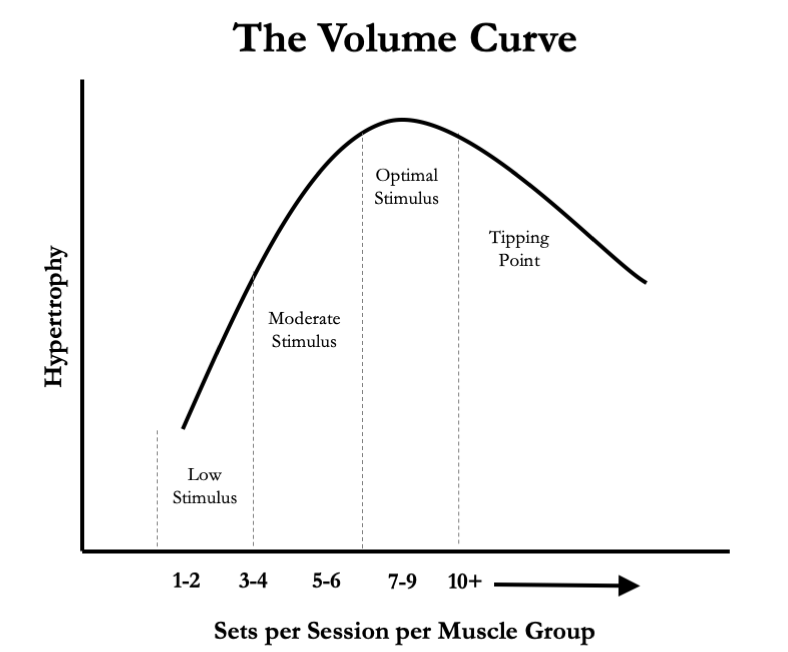This article is a dive into the science of volume for optimizing hypertrophy. I encourage you to read The Hypertrophy Guide that Cody released so that you know the basics.
Volume can be measured in a number of ways. One of those is tonnage (sets x reps x load). Another way is by counting either sets per session or sets per week. There are some issues with how people count volume. For example, you can count sets indirectly, like using a pulldown as half a bicep set, or directly such as counting a barbell row only for the back. In a research lab, the idea of equating training volume between groups is to minimize confounding factors. In the gym, we seldom do that. We will instead count sets or reps or load, but rarely multiply them together and graph out the data much less stick to a certain volume number. That’s why focus on sets seems like such a great idea – it’s easy and practical.
Before we go further there are a few key terms to know when thinking about adaptations to volume, coined by Dr. Mike Isratael. Maintenance Volume (MV), Minimum Effective Volume (MEV), Maximum Adaptive Volume (MAV), and Maximum Recoverable Volume (MRV). While not scientifically validated, they are lay terms to help people understand volume better. If you want to listen to our recent podcast with Mike you can do that here. It’s a great compliment to this article.
This leads us to the ongoing debate on what type of progression or periodization method we should use to optimize hypertrophy. In sports or strength training it’s common to use periodization. There are dozens of types of periodizations to choose from depending on the goal (e.g. linear, undulating, block, agile, etc). The problem with applying these methods to hypertrophy is that they are focused on sports performance or strength. While hypertrophy likely causes increases in strength, we also know that you can increase strength without increasing muscle size. This has lead coaches to speculate on what periodization scheme could be best for hypertrophy, even when there’s little scientific evidence to back it up. That isn’t necessarily bad, but we do need to be careful about how much stock we put into these different methods.
There are two main forms of progression – increasing sets, or increasing reps and load. They come somewhat at a trade-off. If you plan to increase your sets you may not be able to increase your weight or reps across all (or any) sets.
An example of increasing sets can be seen in the graph from Israetal et al., 2019. It demonstrates how you could hypothetically increase sets over time as a form of periodization. Basically, you could increase by two sets per week for five weeks then deload.

An alternative to increasing sets is double-progression. That would be increasing the reps within a rep range (e.g., 8-12) or increasing the load so that you stay within that rep range (+1-5lbs). You can use this system going to failure for each set or using reps in reserve. I’d recommend using RIR since going to failure isn’t necessary to optimize hypertrophy unless you’re using very low loads.
An example would be:
| Week 1 | 135 x 10, 10, 10 |
| Week 2 | 135 x 11, 11, 10 |
| Week 3 | 135 x 12, 12, 11 |
| Week 4 | 140 x 9, 9, 8 |
| Week 5 | 140x, 10, 9, 8 |
This leads us to an important question. Is increasing sets instead of focusing on double progression better? Probably not. Mostly because there are no studies using this method while comparing two groups. On the other hand, the double-progression method has been used for a very long time in dozens of studies to make sure participants stay within a specific repetition range. It’s built into everything we know about strength and hypertrophy. However, if you go looking for studies using it versus other types of progression you won’t find any because it’s already built into the training plans.
There is one study using the set progression method. It’s the Haun et al., 2018 study, which I wrote about focusing on sarcoplasmic hypertrophy here.
The Haun study was one of the highest volume studies to date. It had groups of well-trained, college-aged males, performed 6 weeks of resistance training. The frequency was 3 days per week and each session involved 2 upper and 2 lower-body exercises (10 repetitions/set). Volume increased from 10 sets/exercise (Week 1) to 32 sets/exercise (Week 6). So, we’re going well above our example of 20 sets from above. They ultimately found that participants increased lean body mass ~2.5kg over the study period. If we look at muscle thickness or fiber size there weren’t any changes, which makes the results more difficult to interpret. The initial study was focused on whey supplementation, but it gives us an idea of what would happen if we increased sets over time. From this article some claim that ~20 sets is likely the maximal volume for hypertrophy.
The current data on training volume is reflected by a hormetic curve. The issue with the curve is two-fold:
- It doesn’t apply to everyone.
- It doesn’t have a very good maximum.
Let’s tackle individual heterogeneity first. This is a term for the differences between people. There is an inherent issue with using averages, which is what studies report. Let’s look at this graph from Heaselgrave et al., 2019:

If we apply the set progression method to everyone then we might miss the optimal volume – by undershooting or overshooting the volume curve. We also go up and down the curve too fast across a mesocycle which means we don’t have a good idea where the optimal volume zone is for us. We don’t gain any information on it either since we’re changing everything so much. It’s akin to switching exercises each session. We’re losing the opportunity to learn and gain training momentum.
However, using the double progression method we can make educated guesses on how many sets we should do based on our training experience. For example, if you’ve always done 8 sets per muscle group per session and are having trouble progressing the load or reps, it might be time to add a set. Another option is to change the exercise, but that comes at a cost since you need a week or so to adapt and may lose training momentum.
The second issue with the hormetic curve is we don’t have many high volume studies. This makes it inherently difficult to get an accurate curve. Yes, we have some studies that help but we won’t know for sure until more studies are done.
As I mentioned above: there are no studies that increase sets over time while not decreasing reps or load. It’s the opposite of normal periodization styles where rep ranges (intensity) is adapted. If we care mainly about hypertrophy (we do here) then you probably don’t want to change your intensity too much. High intensities for long periods lead to overreaching and unnecessary stress.
That leads us to the risk of injury. An increase in the risk of injury is not worth the potential increase in hypertrophy we could be getting by doing a step-wise increase in sets as suggested by Israetal et al., 2019. We hit the tipping point in the volume curve too quickly. It just sets us back too much if we have to take 2-3 months off because of a shoulder or wrist issue. There are ways to reduce the risk of injury, so if you are interested you can read the overtraining bible.
When volume starts to increase beyond 8-10 sets per muscle group, it would probably more beneficial to increase training frequency rather than sets within a session. This is because training elevates muscle protein synthesis, and more frequency allows us to have more chances to elevate it. Recent evidence suggests that training frequency doesn’t matter when training volume is equated, but having an extra session gives us a chance to do more volume with a lowered risk of injury so it could be beneficial. This is a reason that the set progression method could be a good tool.
Ok, let’s switch gears and get put or researcher hats on. If we were to design a study to test increasing sets vs double-progression it would probably look something like this:
Group 1 – Start with a standard set number for an exercise (3-4) and increase by 2 sets per week. Increase only sets and do not progress reps or load.
Group 2 – Stick with a standard set number (3-4), but focus on progressing the reps or load each session.
Group 3 (optional) – Use a combination of an increase in sets (+1-2 per week) and double progression
Group 4 (optional) – Have a group that is volume-equated to Group 2 but focuses on set progression.
If we wanted to account for both we need the increase in sets AND a double progression. Would it be too much? Maybe. I’m sure it would work for some people. The obvious issue with the above design is that volume would be a lot higher in Group 1. Since we know volume is the main driver of hypertrophy, we would have to consider that when interpreting the data. That’s why we might even need a fourth group that is volume-equated with Group 2 but focuses on double progression instead of adding sets. This might mean they do more sets with less effective reps. Since we do want to be somewhat near failure (RPE 7-9) this would result in less hypertrophy over time.
Other factors such as study length, rest intervals, deloads, calories, and exercise selection can also influence outcomes, which is why this study is difficult to design and implement hypertrophy research. I’m sure someone will do a study to compare the two methods soon. Until then, we should use the tools that we know work.
So, what’s the take-home?
Increasing sets may not be the best method for optimizing hypertrophy. Instead, use a double progression method until you hit a plateau then deload to see if you’re fatigued. If that doesn’t help you can increase by 1 set, rinse, and repeat. There’s no need to have such huge manipulations in training volume (sets) across a mesocycle to risk potential over- or undertraining.





















































































































































































































































































































































































































































































